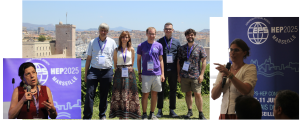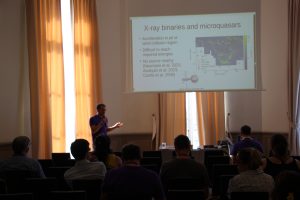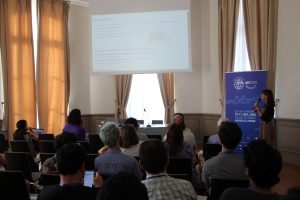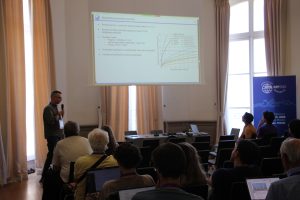18 July 2025 – Last week, leading particle physicists gathered for the “EPS-HEP” biennial conference. This meeting, held by the High-Energy Physics division of the European Physical Society (EPS), is one of the biggest particle physics conferences in Europe. This year, it was also an opportunity to think about what CERN’s next flagship experiments could be, as part of the European Strategy for Particle Physics. In Palais de Pharos, in Marseille (France), around 800 physicists shared news on a wide variety of topics: elementary particle and heavy ion physics at the Large Hadron Collider, dark matter searches, cosmology, constraints on new physics from gravitational wave measurements…and of course neutrino physics.
Neutrinos are very elusive particles, which can be used as cosmic messengers to study violent phenomena in the Universe. At the same time, they could provide a gateway to new physics since some of their properties are not fully understood. KM3NeT exploits both possibilities with its two detectors, ORCA and ARCA. With ORCA we study how atmospheric neutrinos oscillate and with ARCA we can probes high-energy neutrinos from cosmic objects. In addition, KM3NeT can be used to search for dark matter, sometimes performing better than traditional detectors.
This year, EPS featured presentations by six KM3NeT scientists. In particular, Annarita Margiotta, from University of Bologna and INFN, presented an overview of the status of KM3NeT in a plenary talk. She notably highlighted KM3NeT’s latest measurements of the neutrino oscillation parameters. The measurement will allow constraining the neutrino mass ordering and beyond-the-standard model theories. Additionally, she presented KM3NeT’s in-depth studies of the ultra-high-energy KM3-230213A event observed by the experiment in 2023. She also unveiled the collaboration’s first measurement of the atmospheric neutrino flux, and new constraints on astrophysical neutrino fluxes from point-like cosmic sources and from the central regions of the Milky Way.
The plenary presentation was accompanied by five parallel talks from KM3NeT scientists. Victor Carretero (Nikhef, Netherlands) and Chiara Lastoria (CNRS, France) presented respectively KM3NeT’s constraints on the neutrino mass ordering and on the unitarity of the neutrino mixing matrix. At the astrophysics side, Andrey Romanov (CNRS, France) introduced KM3NeT’s first atmospheric neutrino flux measurement. The measurement will be used for studying the composition of cosmic rays as well as for calibrating the detector. Mischa Breuhaus (CNRS, France) discussed why the KM3-230213A event is most likely of extragalactic origin. Finally, Anna Sinopoulou (INFN, Italy) presented KM3NeT’s elaborate computing system. This system is crucial to store and process the colossal volume of data collected by the experiment.
As Annarita highlighted in her presentation, KM3NeT is expected to be completed by the end of the decade. In the meantime, we will continue to deliver relevant physics results on both particle physics and astrophysics. We hope that the results presented at this conference will rouse your interest in KM3NeT’s contributions to the International Cosmic Ray Conference taking place right now in Geneva. There, the collaboration comes in numbers, with 48 presentations and posters!





